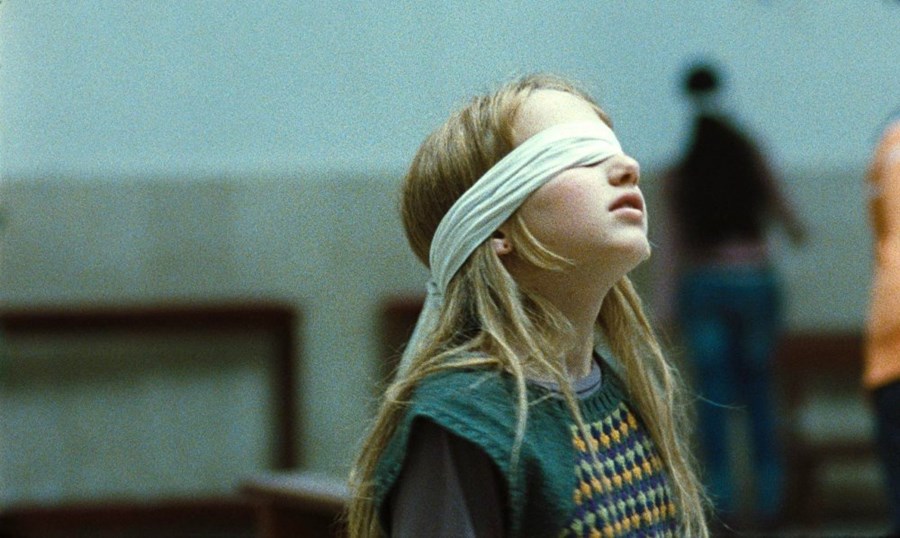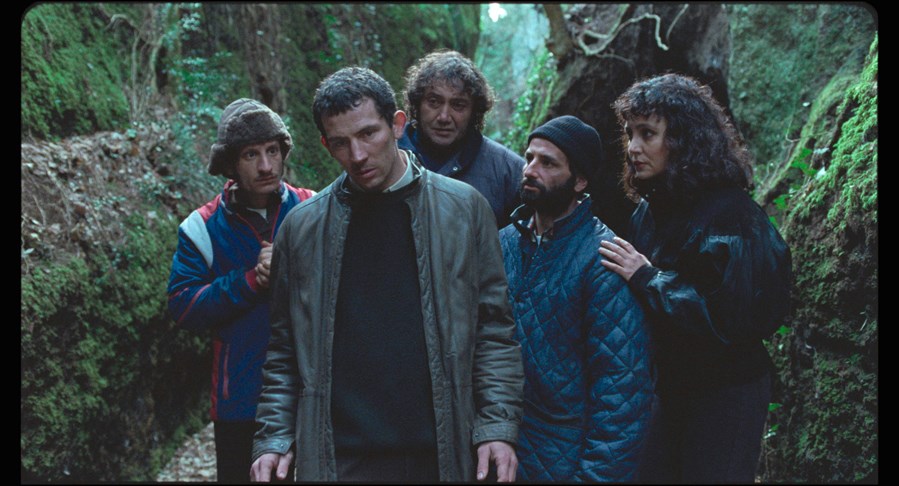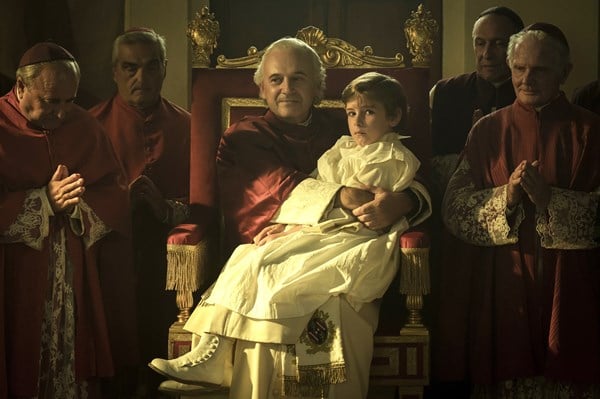Deep within the Umbrian countryside, just under 90 miles north of Rome, there is a garden full of monsters. Constructed in the 16th century by an Italian military leader and patron of the arts, it's said that he filled the garden with stone statues of mythical creatures as an outlet for his grief following the death of his beloved wife. The 'Sacro Bosco' eventually fell into disrepair, and the monsters within slumbered for many years, until Salvador Dalí happened upon them in the 1940s, inspiring renewed interest in the park.
Alice Rohrwacher grew up an hour away from the Sacro Bosco, at Castel Giorgio, where her mother was born. She visited the garden of monsters often. ‘As a child, the stone monsters really frightened me,’ she told Interview Magazine. ‘But there’s one in particular that I was drawn to, and it’s of a little house, and it’s perfect. [...] But the strange thing is it was a little bit tilted. So, when you go in, it’s leaning off to one side. And when you leave, your whole vision has changed. It sort of distorts your picture of reality, and this is something that I try to do in my filmmaking, to give you something that is very real, like that little house, but a little bit askew, because it opens up your vision.’

Sacro Bosco in Bomarzo
The tilted houses of Alice Rohrwacher are bewitching – quiet, delicate spaces, where the lost and the lonely take up residence, moving through their peculiar rooms with a gentle hesitance. In her first construction, 2011's Corpo Celeste (Heavenly Body), 12-year-old Marta (Yile Yara Vianello) – a recent transplant from Switzerland to Calabria in Southern Italy – attempts to navigate the physical and spiritual isolation she feels from her family and the pious local community. She joins the church's confirmation classes but fails to find friends among her peers, struggling with the rigidity of Catholic dogma and unwavering faith that is demanded, all the while those within power are corrupt and, at times, actively cruel.
The rigidity that Marta faces, both in her stoic church classes and at home, where her elder sister reprimands her for bothering their mother, causes her to seek freedom elsewhere. Her curiosity leads her to a group of Calabrian teenagers building a playground for themselves on the town's periphery with unwanted furniture. Here, the setting sun shines brightly on an enclave of scrappy children. This is the world she drifts into – one blissfully separate from the rule of adults, with whom she has become increasingly disillusioned.

Corpo Celeste (2011)
The resourcefulness and resilience of children are displayed again in The Wonders (2014), inspired by Rohrwacher's own childhood as the daughter of beekeepers. As the eldest of four daughters on a dilapidated Italian farm, Gelsomina (Maria Alexandra Lungu) shoulders the burden of being responsible for her younger sisters while assisting with the delicate work of harvesting honey with her stern father. It's a gruelling business and their family live in relative poverty, but make do with their idyll. A chance encounter with an ethereal actress (played by Monica Bellucci, no less!) brings a nationally televised farming competition to Gelsomina's attention and, enamoured by the financial incentive as well as the beguiling film set, she begs her father to enter. But the fetishisation of the working class that the competition demands (complete with costumes and patronising platitudes) cannot hope to tell the real story of Gelsomina's family, eking out an existence that is rapidly disappearing within their homeland. The story becomes more urgent and melancholy than feel-good: unable to compete with industrialisation, the family faces ruin while their mute young farmhand Martin (Luis Huilca) – echoing Marta – takes his chances in the wilderness rather than existing in a world not built for him.

The Wonders (2014)
The theme of vanishing worlds continues in her 2018 film Lazzaro Felice (Happy as Lazzaro). A naive young man working as a sharecropper on a tobacco farm becomes accidentally involved in a fake kidnapping plot at the behest of his mistress' wayward son. While Rohrwacher's first two features hint at elements of magical realism, these become more explicit in Lazzaro Felice, which seems to draw inspiration from Washington Irving's story of Rip Van Winkle, as well as - more unexpectedly perhaps – M. Night Shyamalan's The Village (2004), creating a story of purity and betrayal that lingers after its sharp, stinging end.
While the rural setting is familiar to Rohrwacher's work, this film possesses a more potent air of tragedy, as Lazzaro and his community are exploited throughout history, in a way that reflects the communal experience of society's most vulnerable. Isolated from the rest of society, they have been convinced by the local Marquess that their lot in life is to work her land, constantly indebted to her. The workers, fully aware that sharecropping is unfair, still feel unable to question their exploitation. In turn, they exploit Lazzaro, asking more of him because he is relentlessly generous – the Marquess' son goes as far as to point this out, but suggests this cycle is simply the way of the world.

Lazzaro Felice (2018)
For some, to be gentle is to be weak, and to be weak is to be exploited – but while survival of the fittest has always governed the laws of nature, Rorhwacher suggests a more harmonious relationship is possible, one where the natural world and humanity might live in harmony, were it not for the latter's insatiable greed.
Rohrwacher further explores greed within La Pupille (The Pupil, 2022), her 40-minute short set in a Catholic boarding school during World War II. Serafina (Melissa Falasconi), a defiant young student, is ostracised by both the other girls and the nuns, and when she resists punishment for a false transgression, she is deemed a ‘bad child’. This condemnation leads to further friction, as Serafina (perhaps understandably) fails to see why she should act as a ‘good’ child when the nuns have already condemned her.

It's a brisk, effortlessly charming snapshot of ‘kid logic’ pushing up against dogmatic ideals, shot on the same Super 16 and 35mm formats that Rohrwacher has favoured across her work, creating a rich depth that imbues her films with a sense of time and place. Rohrwacher has worked with the same cinematographer since the beginning of her career, Hélène Louvart (a veteran who counts Agnès Varda, Eliza Hittman and Maggie Gyllenhaal among her collaborators), whose reverence for the natural world and meticulous focus on the beauty of little things (a small hand reverentially grazing a crucifix, the lazy buzzing of a pollen-drunk bee) are in complete synchronicity with Rohrwacher's vision.
Greed is also the beast that stalks La Chimera (2024), in which Rohrwacher again is drawn to the picturesque Italian countryside – this time in Tuscany, where a group of tombaroli (tomb raiders) clumsily excavate Etruscan graves in search of plunder. They are aided in their quest by Arthur (Josh O’Connor), a grieving Englishman who possesses an uncanny gift for unearthing treasure, and a profound melancholy since the death of his great love Beniamina.

La Chimera (2024)
For the first time, Rohrwacher centres on an adult protagonist, and one with a chequered past. Despite his deep love for the relics that he unearths with his gang of graverobbers, Arthur knows what they are doing is wrong, yet seems unable to stop. He eschews his cut of the score, perhaps out of guilt, but his curiosity is never quite satisfied. There is always another treasure to uncover, another thread to pull.
The eerie beauty of the Sacre Bosco is mirrored in Alice Rohrwacher's work, which possesses the same scale and vision as the behemoth statues that bucked the trends of Renaissance style at the time of their creation. Similarly, Rohrwacher moves to her own dreamy rhythms; her films, each a little house in her village, are set slightly off-kilter. Within them are themes we might recognise – family, religion, community, industry – but each is imbued with a sense of quiet magic and myth, calling us to look closer, to reevaluate and reconsider the familiar with new eyes. To watch a Rohrwacher film is to press your ear to the walls, and listen to the secrets within.
La Chimera is in Cinemas from Friday 10 May




